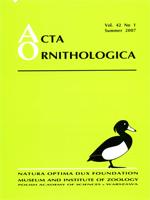The composition and variation of the diet of urban Kestrels in Warsaw (Central Poland) were studied during non-breeding periods (October-March) between 1995 and 2003. A total of 1 651 pellets were collected (at 15 sites), in which 2 390 vertebrate prey items were found. The most common prey were small rodents (80% of items, 78% of biomass), predominantly Common Voles. Birds were markedly less common (7% of items, 11% of biomass). The dietary composition was variable during the cold season. Mean ambient temperature and the consecutive day of the cold season did influence the diet composition but snow depth did not. The main prey category in the Kestrels' diet — Microtidae — remained stable and independent of weather conditions. The percentages of mice and birds were negatively affected by mean ambient temperature, and consumption of birds was higher at the beginning (October) than at the end of the winter (March). Prey number and biomass of prey per pellet decreased during the cold season but were not influenced by temperature. The index of food niche breadth was inversely proportional to temperature.
How to translate text using browser tools
1 July 2007
Weather-Dependent Variation in the Cold-Season Diet of Urban Kestrels Falco tinnunculus
Michał Żmihorski,
Łukasz Rejt
R. Andrzejewski
,
J. Babińska-Werka
,
J. Gliwicz
,
J. Goszczyński
1978. Synurbization process in population of Apodemus agrarius. I. Characteristics of populations in an urbanization gradient. Acta theriol. 23: 341–358. Google Scholar
J. Aschwanden
,
S. Birrer
,
L. Jenni
2005. Are ecological compensation areas attractive hunting sites for common kestrels (Falco tinnunculus) and long-eared owls (Asio otus)? J. Ornithol. 146: 279–286. Google Scholar
Białożej
2003. [Influence of spatial structure of railway areas on the small mammal community]. MSc thesis, Department of Ecology, University of Warsaw. Google Scholar
L. Canova
1989. Influence of snow cover on prey selection by Long-eared Owls Asio otus. Ethol. Ecol. Evol. 1: 367–372. Google Scholar
S. Cramp
,
K. E. L. Simmons
(eds).
1980. The Birds of the Western Palearctic. Vol. II. Oxford Univ. Press. Google Scholar
A. Darolova
1986. [Notes on Kestrels (Falco tinnunculus) diet in Bratislava]. Buteo 1: 33–37. Google Scholar
O. L. Gillbert
1989. The ecology of urban habitats. Chapman and Hall, London-New York. Google Scholar
B. Jędrzejewska
,
W. Jędrzejewski
1998. Predation in vertebrate communities. The Białowieża Primeval Forest as a case study. Berlin, Springer Verlag. Google Scholar
W. Jędrzejewski
,
B. Jędrzejewska
1993. Predation on rodents in Białowieża primeval forest, Poland. Ecography 16: 47–64. Google Scholar
W. Jędrzejewski
,
B. Jędrzejewska
,
K. Zub
,
A. L. Ruprecht
,
C. Bystrowski
1994. Resource use by Tawny Owls Strix aluco in relation to rodent fluctuations in Białowieża National Park, Poland. J. Avian Biol. 25: 308–318. Google Scholar
E. Korpimäki
1985. Diet of the Kestrel Falco tinnunculus in the breeding season. Ornis Fennica 62: 130–137. Google Scholar
E. Korpimäki
1986. Diet variation, hunting habitat and reproductive output of the Kestrel Falco tinnunculus in the light of the optimal diet theory. Ornis Fennica 63: 84–90. Google Scholar
E. Korpimäki
,
K. Norrdahl
1991. Numerical and functional responses of Kestrels, Short-eared Owls and Long-eared Owls to vole densities. Ecology 72: 814–826. Google Scholar
S. Kübler
,
S. Kupko
,
U. Zeller
2005. The kestrel (Falco tinnunculus L.) in Berlin: investigation of breeding biology and feeding ecology. J. Ornithol. 146: 271–278. Google Scholar
M. Luniak
2004. Synurbization — adaptation of animal wildlife to urban development. In:
W. W. Shaw
,
L. K. Harris
,
L. Vandruff
(eds).
Proc. 4th Int. Symposium Urban Wildl. Conserv. Tucson, pp. 50–55. Google Scholar
E. Moreno
1985. [Osteological key for identification of Iberian Passeriformes]. Ardeola 32: 295–377. Google Scholar
J. Pikula
,
M. Beklova
,
V. Kubik
1984. The nidobiology of Falco tinnunculus.
Academia, Praha. Google Scholar
Z. Pucek
,
W Jędrzejewski
,
B. Jędrzejewska
,
M. Pucek
1993. Rodent population dynamics in a primeval deciduous forest (Białowieża National Park) in relation to weather, seed crop, and predation. Acta theriol. 38: 199–232. Google Scholar
J. Raczyński
,
A. L. Ruprecht
1974. The effect of digestion on the osteological composition of owl pellets. Acta Ornithol. 14: 25–38. Google Scholar
Ł. Rejt
2001. Peregrine Falcon and Kestrel in urban environment — the case of Warsaw. In:
E. Gottschalk
,
A. Barkow
,
M. Muehlenberg
,
J. Settele
(eds).
Naturschutz und Verhalten. UFZ-Bericht 2: 81–85. Google Scholar
Ł. Rejt
2004. [Variability of the diet of Kestrel Falco tinnunculus in Warsaw]. Notatki Ornitologiczne 45: 215–228. Google Scholar
Ł Rejt
.
2007. [Breeding biology of urban Kestrel Falco tinnunculus in Warsaw]. Ph. D. thesis, Museum and Institute of Zoology, Polish Academy of Sciences. Google Scholar
Ł. Rejt
,
A. Gryczyńska-Siemiątkowska
,
R. Rutkowski
,
A. Malewska
2005. Does egg sex ratio in urban kestrels (Falco tinnunculus) differ from parity? Pol. J. Ecol. 53: 545–552. Google Scholar
Ł. Rejt
,
R. Rutkowski
,
A. Gryczyńska-Siemiątkowska
2004. Genetic variability of urban Kestrels in Warsaw — preliminary data. Zool. Poloniae 49: 199–209. Google Scholar
J. Romanowski
1996. On the diet of urban Kestrels (Falco tinnunculus) in Warsaw. Buteo 8: 123–130. Google Scholar
L. Salvati
,
A. Manganaro
,
S. Fattorini
,
E. Piatella
1999. Population features of Kestrels Falco tinnunculus in urban, suburban and rural areas in Central Italy. Acta Ornithol. 34: 53–58. Google Scholar
P. Śliwa
,
Ł. Rejt
2006. [The Kestrel]. Wyd. Lubuskiego Klubu Przyrodników, Świebodzin. Google Scholar
L. Tomiałojć
,
T. Stawarczyk
2003. [Awifauna of Poland]. PTTP “proNatura”, Wrocław. Google Scholar
J. Viitala
,
E. Korpimäki
,
P. Palokangas
,
M. Koivula
1995. Attraction of kestrels to vole scent marks visible in ultraviolet light. Nature 373: 425–427. Google Scholar
A. Village
1983. Seasonal changes in the hunting behavior of kestrel. Ardea 71: 117–124. Google Scholar
A. Wuczyński
2005. Habitat use and hunting behaviour of Common Buzzards Buteo buteo wintering in south-western Poland. Acta Ornithol. 40: 147–154. Google Scholar

Acta Ornithologica
Vol. 42 • No. 1
July 2007
Vol. 42 • No. 1
July 2007
ambient temperature
diet variability
Falco tinnunculus
Kestrel
urban habitat




